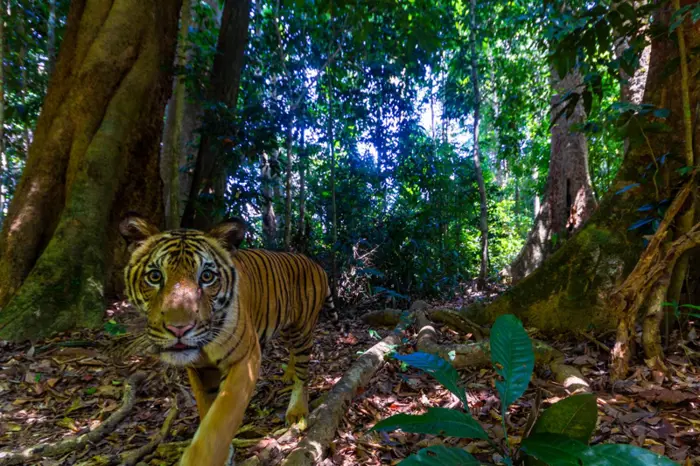By Ho Jia Wen
KINABATANGAN: Peaceful coexistence between wildlife and humans is crucial, especially at oil palm plantations in eastern Sabah, where the estates are adjacent to dense forest.
Wildlife such as pygmy elephants (also known as the Bornean elephant), orangutans and hornbills often cross into the estates and cause damage, while humans also harm the animals.
The sustainable way is to coexist in harmony, which is both important for conservation and to mitigate crop damage.
One of the plantation companies for oil palm and softwood in Tawau, Sabah mitigates Bornean elephants trampling over the plantation by setting aside 1067 ha to be a Brumas Wildlife Corridor.
By doing this, Sabah Softwood Berhad Conservation Unit Head Mohd Hafizzul Samut said that the company has reduced their losses by 99%, from half a million ringgit a year to RM5,000.
He said that the 14km long corridor connects two large forest reserves, Ulu Kalumpang and Ulu Segama, and provides a pathway for the wildlife to travel from one forest to another.
The wildlife corridor was formerly a timber plantation, but the area has been rehabilitated into a forest, he said.
Since the establishment of the corridor, Mohd Hafizzul said that conflicts between humans and Bornean elephants have reduced.
“Bornean elephants now coexist more peacefully with communities and are no longer startled when encountering people in the area. If they need to pass through, they do so calmly,’ he said.
He highlighted that Bornean elephants also help when oil palm areas are replanted.
“When old trees are felled by excavators and chipped into smaller pieces.
“Elephants act like supervisors—they monitor the chipping process and eat the chippings, which makes the work easier for us,” he said.
To attract wildlife to the corridor, the team has also planted fruit trees and placed artificial saltlicks nearby.
He said that since the conservation and rehabilitation of the forest has started, the number of Bornean elephants sighted has increased by 75%.
“Elephants in the area have also increased from 50 to 120,” he said.
Only 7,000ha (11%) of Sabah Softwoods estate’s 60,000ha is allocated for conservation, which includes the 1,067-ha wildlife corridor.

According to Mohd Hafizzul, there are no plans to increase the conservation area.
He added that every hectare of softwood plantations can gain a profit of RM25mil every five years.
The company is also venturing into opportunities for ecotourism, such as doing a night safari.
Malaysian Palm Oil Green Conservation Foundation (MPOGCF) executive Daniel Pamin said that Kinabatangan is a unique area, with a combination of forest and plantation areas.
He said there are also large groups of orangutans and Bornean elephants concentrated in the area.
“There is a special connection between the oil palm agriculture industry and the wildlife here, as the plantations are right next to the dense forest,” he said.
The movement of wildlife between forests and plantation sites is inevitable, he said, hence most of the foundation’s projects are concentrated in the Kinabatangan area.
“We cannot go back to the way the forest was before. What we can do now is to be sustainable, that is the main important agenda here,” he said.
The foundation works to introduce the concept of the coexistence between humans and wildlife, he said, and ecotourism is one of the ways to promote it.
Sabah Softwood Berhad’s conservation project is part of the foundation’s efforts, as well as the Sungai Pin Conservation Area (SPnCA) and the Borneo Elephant Sanctuary (BES).
District Manager for Kinabatangan and Tongod at the Sabah Wildlife Department Sylvia Asisto said that Bornean elephants can only be found in the East Coast of Sabah, and have to compete with humans for land.
She said that one of the Bornean elephant’s biggest sources of conflict is humans, which has resulted in death for both sides.
Her team of elephant conservationists trains the local community to mitigate wildlife conflict and rescue elephants.
“The team has to respond quickly to emergency calls on elephants or wildlife quickly to prevent retaliatory killing,” she said, adding that she has received calls even at midnight to remove elephants who have gone rogue.
The team has rescued Bornean elephants who rampaged and attacked villages, as well as baby elephants who are separated from the herd.
The Bornean elephants are then relocated to BES, an elephant sanctuary that is located in an area where incidents of human and elephant conflict are high.
Currently the sanctuary houses six elephants, including two new rescued baby elephants.
“Our policy is to release them to the wild as soon as we can. However, some will remain as they are unfit to be released,” she said.
She said that the sanctuary will expand to include an elephant veterinary and holding area for RM2.7mil, which is funded by MPOGCF.
Plans to open the sanctuary are in the works, but road access to the sanctuary needs to be improved first, she added.
Separately, the pilot project for the revised ‘orangutan diplomacy” initiative will be carried out with Sawit Kinabalu.
Local plantation companies can support the programme by contributing a minimum amount of RM10,000, according to MPOGCF.
Currently there are 55 orangutans in the Sawit Kinabalu area, which companies can ‘adopt’.
Orangutans will remain in their habitat while the funds will be channelled for further conservation efforts.
The project is expected to commence next year.
Sawit Kinabalu has also rehabilitated 2,632 hectares of land to forest from oil palm plantations.
According to its manager, Kinabalu Palm Conservation and Biodiversity Unit (ConsereByU) Charis Saliun, the orangutan population has increased from 37 to 55 from 2014 to 2019 following conservation efforts.
He also said that they will start ecotourism packages soon so that visitors can see the wildlife in the area.
Malaysian Palm Oil Green Conservation Foundation (MPOGCF) organised a media familiarisation trip (Nov 12-16) to the project sites to highlight their initiatives.
Follow our Facebook page ConserveByU for our latest updates.






